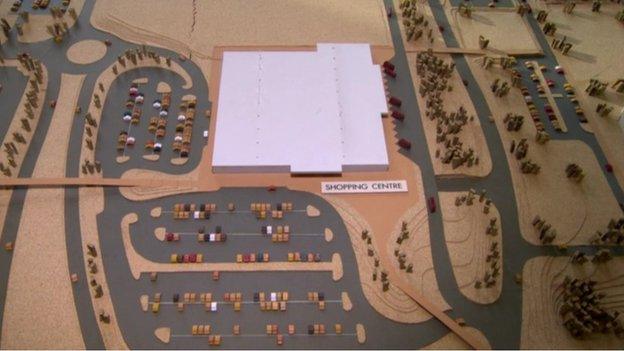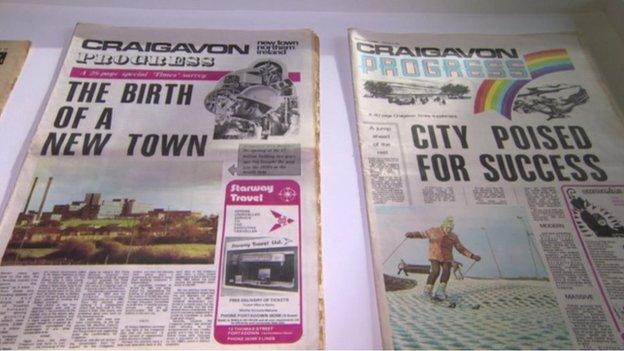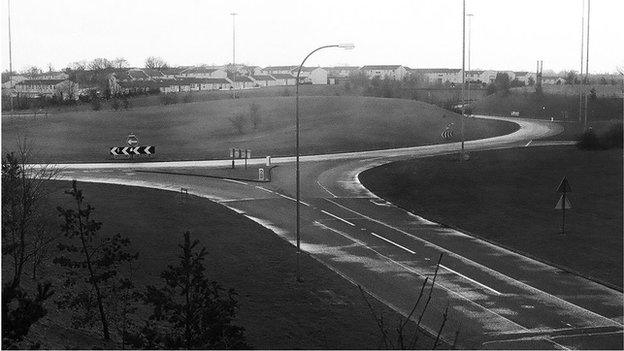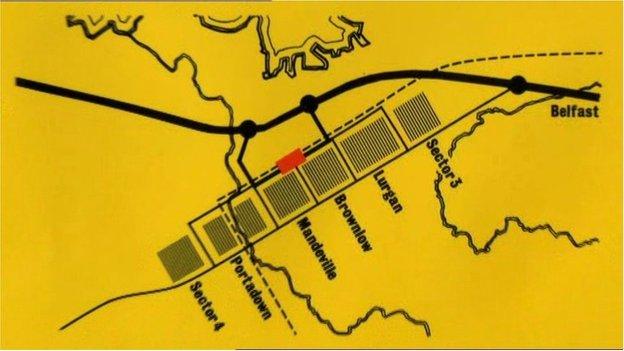Craigavon town planning: British Modernism 50 years on
- Published

The science of town planning: Models used in the planning stage are on display at the exhibition.
It was conceived as a vision of the future for Northern Ireland, but the reality has been described as "fundamentally flawed".
The new town of Craigavon was created in County Armagh in the 1960s to realise all the aspirations of Modernist architecture and town planning.
The dream quickly turned sour and the reality was a "soulless" urban space notorious for its many roundabouts.
The story of Craigavon has now come full circle and a new exhibition has opened to detail its history.
Curator of the exhibition, Rebekah McCabe, said: "In terms of vision, Craigavon during the 1960s embodied every value of British Modernism.
'Cross community buy-in'
"Its innovative and risky housing design drew inspiration from around the world, rejecting indigenous housing styles and embracing modern European aesthetics.
"This exhibition reveals the bright ambitions of the project and how its origins were part of Prime Minister Terence O'Neill's vision of a modern Northern Ireland in the 1960s, where town planning concepts included recreation zones, mixed housing, cycle paths and roundabouts."
Named after Northern Ireland's first prime minister, Lord Craigavon, many felt the town was created for the Protestant community.
Dr Stephen McKay, director of education at the School of Planning, Architecture and Civil Engineering at Queen's University in Belfast, said: "The Craigavon brand was fundamentally and fatally flawed from the outset. Naming it after the first unionist prime minister was perhaps an unwise opening move in terms of achieving cross-community buy-in."

Local papers celebrate the birth of Craigavon
Displacement
Grants were offered to encourage people to relocate to Craigavon from Belfast.
Dr McKay said: "Belfast had been expanding at a fearful rate to the detriment of the rest of the country and, consequently, constraining its expansion and developing new growth centres should have been a good idea. However, many believe that the selection of Craigavon was perverse, and the inevitable impact was to divert resources away from other needy locations in the west, particularly Derry."
The exhibition also recalls the displacement of farming families who had to move out of the area between Lurgan and Portadown when construction began.
Dr McKay said: "In terms of the built environment many problems emerged in the big housing estates as a result of using untested methods and materials.
"Closure of the infamous Goodyear Tyre plant, which provided a huge amount of employment, hit the emerging community like a torpedo.
"The cycle ways, mixed housing and recreational zones were really never going to work in light of the circumstances. The manifestation of Craigavon to many was effectively a series of roundabouts."

Central way. 1981
New start
Craigavon's design often draws comparisons with Milton Keynes, Buckinghamshire.
Ms McCabe said: "Today it feels like Craigavon has come full circle, with new developments springing up everywhere and people not just from Northern Ireland but from all over the world moving there. It's a very progressive place to live."
Dr McKay agreed: "Things may be far from perfect, but in my opinion, the planning service deserves tremendous credit for turning things around as well as it has."
Events
The exhibition, Craigavon New Town: 50 Years of Modernity, is on at the Golden Thread Gallery, Belfast from 24 October until Saturday, 1 November.
The Ulster Museum was screening the film, The Lost City of Craigavon, on Saturday, 25 October.
A bus tour of Craigavon guided by Rebekah McCabe will take a journey through the city's history on Saturday, 1 November.

Craigavon was built in the 1960s, with a modernist vision

Big plans: Craigavon on paper

Craigavon's design incorporated public transport and cycle paths

The choice of location for Craigavon was controversial. The population only reached about a tenth of the anticipated size.